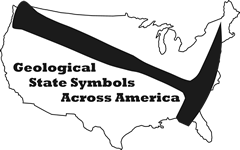Tennessee
Type |
Symbol |
Year Est. |
|---|---|---|
State Rock |
Limestone |
1979 |
State Mineral |
Agate |
1969 |
State Gem |
Tennessee River Pearl |
1979 |
State Fossil |
Pterotrigonia |
1998 |
State Rock: Limestone
Limestone is one of the main sedimentary rocks, along with sandstone and shale. Limestone is often formed from the carbonate shells of aquatic animal life, since most shelly animals makes their shells out of a variety of carbonates (CaCO3). One of the hallmarks of carbonates is that they react with acid, making limestones fairly easy to identify as a whole. However there are multiple varieties of limestones depending on where there were formed, what their primary mineral is, the size and types of the fossils within the limestone, and what type of cement is present within the rock. These include fossiliferous limestone, coquina, chalk, micrite, crystalline limestone, oolitic limestone, and travertine. Fossiliferous limestone is formed usually on the continental shelf from the large shells of animals like clams and snails cemented together with microscopic calcium carbonate shells, called lime mud. Coquina is typically formed in beach like environments where the number of animal shells far exceeds the surrounding sediment. Although some definitions vary, the typical definition is that coquina is made up of loosely cemented shells with little to no matrix (cement). Chalk is formed from the compaction of microscopic plates called coccoliths, which come from animals called coccolithophores. Similar to fossiliferous limestone except the rock is typically all white and contains only one type of fossil. Micrite is comprised primarily of lime mud, like a fossiliferous limestone without the fossils. It forms a little further out from the shoreline than fossiliferous limestone where the mud can float out in the water but is generally too deep for shelled animal life. Crystalline limestone is an inorganic type of limestone that usually forms in shallow lagoons or lakes. The water in the lagoon becomes saturated in calcite and then the water starts to evaporate causing calcite to precipitate out of the rock. This is common where water is periodically added to a lagoon or a lake after a lot of calcite is precipitated out. It is also found when other types of limestone are altered in some way. Oolitic limestone is another inorganic type of limestone where limestone mud is deposited along the continental shelf edge and the naturally movement of the water rolls the mud around creating little balls of calcite. These little calcite balls are then cemented together. And the last limestone variety, travertine, is formed in caves from the deposit of calcite along stalactites, stalagmites, and other flowstones. Since the structures are built up layer by layer, this causes the rocks to often have a banded appearance with often a lot of holes within it.
State Mineral: Agate
State Gem: Tennessee River Pearl
State Fossil: Pterotrigonia
References
https://statesymbolsusa.org/states/united-states/tennessee
Geology of Tennessee's National Parks
Through Pictures
(at least the one's I have been to)
Chickamauga & Chattanooga National Military Park
Great Smoky Mountains National Park
Chickamauga & Chattanooga National Military Park
Visited in 2018
Chickamauga & Chattanooga NMP is a weird park because it is comprised of two distinct districts, with two very distinct geological settings, in two different states. So, that being said, I have decided to do this park in two parts, one for each state. The first part of the park that we visited was the part in Tennessee called Point Park. The second part in Georgia can be found HERE. This is a really cool park to get to because it is located at the top of Lookout Mountain, which is a rather steep drive up, or you can do what we did, and take the Incline Railroad up the mountain and walk over to the park from the top of the railroad.
.jpg)
Here is a shot of the Incline Railroad from the top station looking down Lookout Mountain towards Chattanooga. We'll get into the geology of Lookout Mountain in a bit.
.jpeg)
For the entrance sign at this part of the park, I took a shot of the Point Park Gate, which in and of itself, has beautiful building stones.
.jpeg)
Here is a closeup of the Point Park Gate to check out the sandstone blocks. The blocks are beautiful but I can't find any sources for the blocks. My assumption would be that they are a local building stone. The one that seems to fit best is the Sewanee Sandstone. This is a local building stone that has been used in the town of Swanee nearby and is also found as the caprock of Lookout Mountain. The Sewanee Sandstone is Lower Pennsylvanian in age (~320 million years old) and was deposited as barrier bar deposits. It is a course-grained, conglomeratic, cross-bedded sandstone. The cross beds are what are highlighted by the darker brown lines through the blocks.
.jpeg)
Here is a view off towards Chattanooga towards the east. The river in the picture is the Tennessee River. Lookout Mountain is a part of the Ridge and Valley Province of the Appalachian Mountains. This is a section of linear NE-SW trending synclines (rocks bent like a "U") and anticlines (rocks bent like an "A"). These rocks were folded during the mountain building event (orogeny) called the Alleghenian Orogeny. This is when North America slammed into Africa around 300 million years ago (Late Pennsylvanian to Early Permian) making North America crumple up, forming part of the Appalachian Mountains. The rocks in the region are mostly made up of limestones and shales, however there are significant amounts of sandstone in the area, such as the ones used for the Point Park Gate above.
.jpg)
This is the New York Peace Monument, which was built in 1910. The building stones used for the structure are Tennessee marble and Massachusetts pink granite. Tennessee Pink Marble is interesting in that it actually isn't a marble, it is a limestone, meaning it was never metamorphosed. The "marble" even includes such sedimentary structures as cross bedding, bryozoan fossils, crinoid fossils, and stylolites. The rock is part of the Holston Formation, which formed 460 million years ago during the Middle Ordovician, along the continental shelf of Laurentia (the northern continent). The Tennessee Pink Marble is found along the eastern part of Tennessee, near Knoxville and was also used in the Jefferson Memorial and the Lincoln Memorial in DC.
.jpg)
A close up shot of one of the columns, highlighting the Massachusetts pink granite, although the lighting of the photo doesn't really emphasize the pinkness. The Milford Pink Granite from Massachusetts is likely the granite which was used. The granite is a 630 million year old, Proterozoic igneous rock located in and around Milford, MA, covering an area of ~100 km2. The granite was initially discovered in the 1870's and was noted for its pink quality, although there is variation within the body. The colors range from light-gray to pale orange-pink. Milford Pink Granite has also been used in the Lincoln Memorial in DC.
.jpeg)
Although the mountain is mainly comprised of limestone and shale, there is a caprock of sandstone which covers the mountain. This is the same Sewanee Sandstone that I am guessing was used as the building stone of the Point Park Gate above.
.jpeg)
A shaded view of the Ochs Memorial Observatory on the northern end of Point Park. The building here is noted as using a local sandstone as the building stone so I am under the assumption that it is also built using the Sewanee Sandstone. There is also a rather interesting Cherokee take on the geology of the region that was on a sign at the park:
"At first the earth was flat and very soft and wet. The animals were anxious to get down (from above in Galunlati, beyond the arch) and sent out different birds to see if it was yet dry, but they found no place to alight and came back again to Galunlati. At last, it seemed to be time, and they sent out the Great Buzzard, the father of all the buzzards we see now. He flew all over the earth, low down near the ground, and it was still soft. When he reached the Cherokee country, he was very tired, and his wings began to flap and strike the ground, and wherever they struck the earth there was a valley, and where they turned up again there was a mountain. When the animals above saw this, they were afraid that the whole world would be mountains, so they called him back, but the Cherokee country remains full of mountains to this day." From the Native History Association
References
https://www.stoneworld.com/articles/82290-tapping-the-stone-foundation-of-sewanee
https://doi.org/10.1130/0-8137-5406-2.153
https://www.ncptt.nps.gov/buildingstone/stone/milford-pink-granite
https://mrdata.usgs.gov/geology/state/sgmc-unit.php?unit=MAZmgr%3B0
https://www.gettysburgdaily.com/lincoln-memorial/
http://www.nativehistoryassociation.org/creation.php
https://www.nps.gov/parkhistory/online_books/chch/hrs/chapter2.pdf
Great Smoky Mountains National Park
Visited in 2003
.jpg)
For all of the pictures from Great Smoky Mountain National Park be sure to head over to the:



